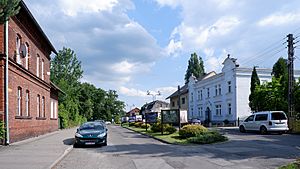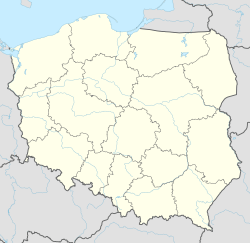Zdzieszowice facts for kids
Quick facts for kids
Zdzieszowice
|
|||
|---|---|---|---|

Dworcowa Street
|
|||
|
|||
| Country | |||
| Voivodeship | Opole | ||
| County | Krapkowice | ||
| Gmina | Zdzieszowice | ||
| Area | |||
| • Total | 12.35 km2 (4.77 sq mi) | ||
| Population
(2019-06-30)
|
|||
| • Total | 11,445 | ||
| • Density | 926.7/km2 (2,400.2/sq mi) | ||
| Time zone | UTC+1 (CET) | ||
| • Summer (DST) | UTC+2 (CEST) | ||
| Postal code |
47-330
|
||
| Car plates | OKR | ||
| Website | http://www.zdzieszowice.pl | ||
Zdzieszowice is a town located in Poland. It is part of the Opole Voivodeship region. About 11,445 people lived there in 2019. The town is known for its history, especially its role during a major world conflict.
Contents
A Look at Zdzieszowice
Zdzieszowice is a friendly town in the Krapkowice County. It sits in a beautiful part of Poland. The town has a mix of modern and older buildings. You can find schools, shops, and places to relax.
Location and Surroundings
Zdzieszowice is in the southwestern part of Poland. It is close to the Odra River. This river is one of the longest in Poland. The area around Zdzieszowice is mostly flat. It has some forests and farmland.
Life in the Town
Life in Zdzieszowice is calm and welcoming. Many people work in local industries. The town has good connections to other cities. This is thanks to its railway station. It helps people travel and goods move around.
History of Zdzieszowice
Zdzieszowice has a long and interesting past. It was first mentioned many centuries ago. The town grew over time. It became an important place for industry.
Industrial Growth
In the early 20th century, Zdzieszowice became known for its factories. A large plant was built there. This plant made special fuels. It started making these fuels in 1939. This made the town very important.
Role in World War II
During World War II, the fuel plant in Zdzieszowice was very important. It produced fuel for vehicles and machines. Because of this, it became a target. Air forces tried to stop its production. This part of the war was called the "Oil Campaign." It showed how vital the plant was.
Gallery








